Facing History: The Black Image in American Art, 1710–1940 was the first public exhibition by a major museum to showcase depictions of African Americans in American art.[1] Facing History took place in 1990 and was held at the Corcoran Gallery of Art from January 13 through March 25, and then went to the Brooklyn Museum from April 20 through June 25. The curator of the exhibition, Guy McElroy, died during the Brooklyn portion on May 31.[2]
History
Facing History examined ways in which American artists "...reinforced a number of largely restrictive stereotypes of black identity."[3] The exhibition featured eighty works in three media: drawings, paintings, and sculptures [4]
Curator Guy McElroy viewed the exhibition as depicting the attitude of society toward African Americans through the works themselves and the response they received in the art market. They made overt political statements, as well as having addressed contemporary issues. Stereotypes, slavery, and violence dominated the images. However, as McElroy stated in the exhibition catalog:
Depictions of black people can no longer rely on gross distortions of physiognomy or character to achieve racially motivated humor, but the symbolic power of visual images remains insidious. Jim Crow, Uncle Tom, Mammy, the Comic Darkey and Zip Coon no longer dominate images of African-Americans in painting and sculpture, but their ghosts live on in a host of popular mediums, most notably in the violence of action serials and the stereotyped behavior of television sitcoms.
— Guy McElroy, "Introduction: Race and Representation", Facing History, 1990
Selected works
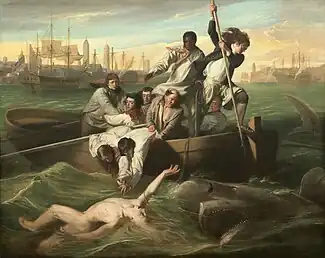
 Liberty Displaying the Arts and Sciences by Samuel Jennings, 1792
Liberty Displaying the Arts and Sciences by Samuel Jennings, 1792_by_Joshua_Johnson.jpg.webp) Abner Coker by Joshua Johnson, c. 1807
Abner Coker by Joshua Johnson, c. 1807 Winter Scene in Brooklyn by Francis Guy, c. 1820
Winter Scene in Brooklyn by Francis Guy, c. 1820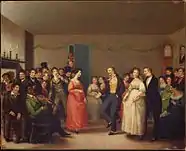 Rustic Dance After a Sleigh Ride by William Sidney Mount, 1830
Rustic Dance After a Sleigh Ride by William Sidney Mount, 1830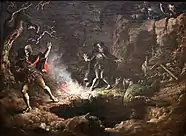 The Money Diggers by John Quidor, 1832
The Money Diggers by John Quidor, 1832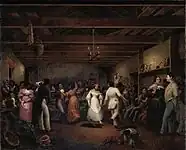 Kitchen Ball by Christian Friedrich Mayr, 1838
Kitchen Ball by Christian Friedrich Mayr, 1838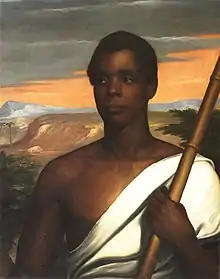 Joseph Cinqué by Nathaniel Jocelyn, 1840
Joseph Cinqué by Nathaniel Jocelyn, 1840 Militia Training by James Goodwyn Clonney, 1841
Militia Training by James Goodwyn Clonney, 1841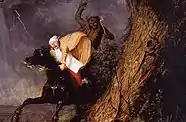 The Devil and Tom Walker by Charles Deas, 1843
The Devil and Tom Walker by Charles Deas, 1843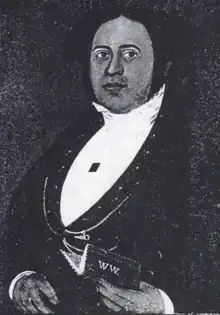 William Whipper by William Matthew Prior, 1845
William Whipper by William Matthew Prior, 1845 Eel Spearing at Setauket by William Sidney Mount, 1845
Eel Spearing at Setauket by William Sidney Mount, 1845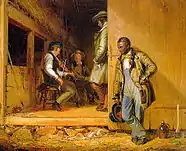 The Power of Music by William Sidney Mount, 1847
The Power of Music by William Sidney Mount, 1847 Old and Young 48 by Richard Caton Woodville, Sr., 1849
Old and Young 48 by Richard Caton Woodville, Sr., 1849 Waking Up by James Goodwyn Clonney, 1851
Waking Up by James Goodwyn Clonney, 1851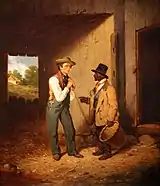 All Talk and No Work by Francis William Edmonds, c. 1855
All Talk and No Work by Francis William Edmonds, c. 1855 The Bone Player by William Sidney Mount, 1856
The Bone Player by William Sidney Mount, 1856 Market Woman by Thomas Waterman Wood, 1858
Market Woman by Thomas Waterman Wood, 1858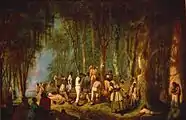 Plantation Burial by John Antrobus, 1860
Plantation Burial by John Antrobus, 1860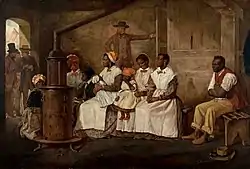 Slaves Waiting for Sale by Eyre Crowe, 1861
Slaves Waiting for Sale by Eyre Crowe, 1861 The Watermelon Boys by Winslow Homer, 1876
The Watermelon Boys by Winslow Homer, 1876 Rail Shooting by Thomas Eakins, 1876
Rail Shooting by Thomas Eakins, 1876
References
- ↑ Kastor, Elizabeth (1990-01-14). "Guy Mcelroy, Facing His Future". The Washington Post. Retrieved 2022-06-21.
- ↑ Glueck, Grace (5 June 1990). "Guy McElroy, Art Historian, 44; Organized Show on Black Images". The New York Times.
- ↑
- ↑ "Archives". Los Angeles Times. 18 February 1990.